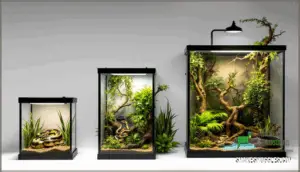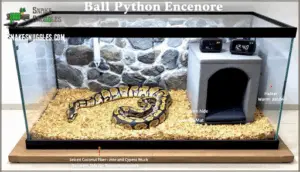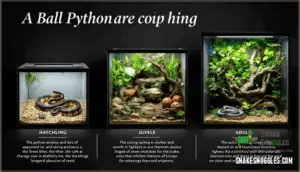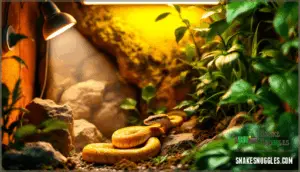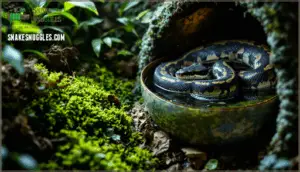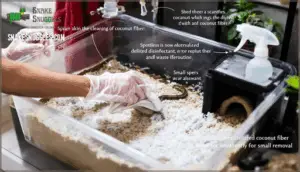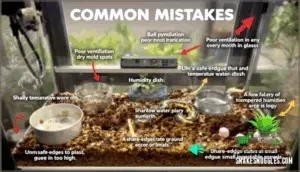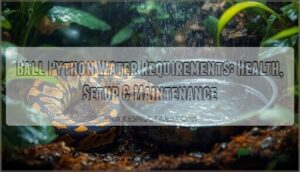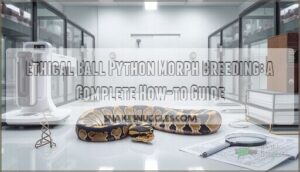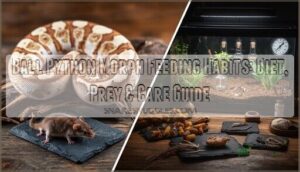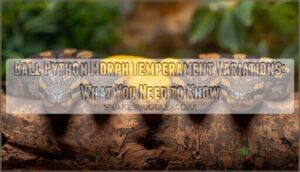This site is supported by our readers. We may earn a commission, at no cost to you, if you purchase through links.
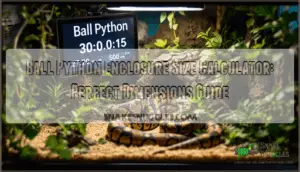
The good news is that sizing an enclosure correctly isn’t complicated; you just need to know what your python actually needs at each stage of its life. Whether you’re setting up for a hatchling or upgrading for an adult, a ball python enclosure size calculator removes the guesswork out of the equation and makes certain your snake has the space to thrive.
Table Of Contents
- Key Takeaways
- Ball Python Enclosure Size Calculator
- Choosing The Right Enclosure Size
- Ball Python Growth and Space Needs
- Recommended Enclosure Dimensions
- Types of Ball Python Enclosures
- Enclosure Layout and Environmental Design
- Temperature and Lighting Setup
- Humidity and Hydration Management
- Cleaning and Maintenance Routines
- Common Enclosure Mistakes to Avoid
- Frequently Asked Questions (FAQs)
- How big should my ball python tank be?
- Is a 40 gallon tank big enough for a ball python?
- Can a ball python live in a 20 gallon tank?
- Can a ball python tank be too big?
- How to quiet a ball pythons cage rattling?
- Do ball pythons need a climbing area?
- Can ball pythons share an enclosure with other reptiles?
- How to reduce odors in a ball pythons tank?
- What plants are safe in a ball pythons enclosure?
- Can ball pythons live in enclosures smaller than recommended?
- Conclusion
Key Takeaways
- Ball pythons need at least 8 square feet of floor space and 48" x 24" x 24" dimensions as adults, and failing to provide adequate room causes a 40% drop in movement, leading to muscle atrophy, obesity, and stress-related health problems.
- Your snake’s enclosure size needs change dramatically across life stages—hatchlings under 300g thrive in 10-gallon tanks, juveniles need 36"x18"x18" setups, and adults require larger spaces—so using an enclosure size calculator prevents undersizing at each growth phase.
- Proper thermal gradients with a warm end at 88-92°F and cool end at 78-80°F are essential for thermoregulation, and without a thermostat controlling heat sources, temperatures can spike dangerously or drop too low within hours, compromising your snake’s metabolic health.
- Humidity between 50-60% (bumped to 70-80% during shedding), a water bowl large enough for soaking, and proper ventilation prevent respiratory infections and shedding problems, while spot-cleaning waste immediately and deep-cleaning every six months eliminates bacterial buildup that causes scale rot and infections.
Ball Python Enclosure Size Calculator
Choosing the right enclosure size for your ball python doesn’t have to feel like guesswork. An enclosure size calculator takes the math out of the equation and helps you match your snake’s measurements to the proper dimensions.
Below, you’ll find clear guidelines to measure your python, calculate the space it needs, and understand what those numbers really mean.
How to Use an Enclosure Size Calculator
An enclosure size calculator takes the guesswork out of choosing the right home for your ball python, but you’ll need a few basic measurements to get started. Simply input your snake’s length in inches or centimeters—most calculators process unit conversions automatically.
The formula variations usually multiply your snake’s length by specific factors to determine minimum enclosure dimensions for floor area and height. After inputting this data, you’ll receive recommended enclosure size requirements that match your ball python’s current needs.
Measurement Guidelines for Ball Pythons
Before you punch your snake’s length into a calculator, you need to measure accurately—and that means getting your ball python to stretch out without stressing them out. Place your snake along a measuring tape or ruler when they’re naturally moving, not coiled up. You can also use a flexible tape to trace their body from nose to tail tip, which captures their true length without forcing them to straighten.
This measurement determines enclosure ratios for proper space utilization, making sure your ball python enclosure size matches their growth stages.
Calculating Floor Space and Volume
Once you have your snake’s length, multiply the enclosure’s length by its width to get floor space in square inches—then divide by 144 to convert to square feet—while multiplying all three dimensions gives you the total cubic volume.
Here’s what matters when calculating enclosure size:
- Floor area should equal at least 8 square feet for adults
- Cubic volume guarantees adequate vertical space for climbing
- Measurement accuracy prevents undersizing your ball python enclosure size
- Enclosure dimensions must accommodate thermal gradients properly
- Space utilization promotes natural movement and thermoregulation
Always round up when you’re between sizes—your snake won’t complain about extra room.
Choosing The Right Enclosure Size
Getting the enclosure size right depends on where your ball python is in life. Hatchlings need far less room than full-grown adults, and choosing incorrectly can stress your snake or waste your money on upgrades.
Let’s break down what works at each life stage so you can pick an enclosure that fits now and plan for what’s ahead.
Hatchling and Juvenile Enclosure Requirements
Young ball pythons aren’t miniature adults—they need specific housing that balances security with room to grow, and getting it right from day one sets the stage for healthy development.
Hatchlings under 300g thrive in 10-gallon enclosures or tubs, while juveniles move to 36"x18"x18" setups as they approach three feet. These enclosure dimensions prevent stress while supporting natural behaviors and exploration.
Adult Ball Python Minimum and Maximum Sizes
Adult females generally stretch 3–5 feet, while males stay closer to 2–3 feet—sexual dimorphism that directly impacts enclosure dimensions. Captive size trends show most adults peak around 4–5 feet, with wild size variation running smaller. Maximum size outliers rarely exceed 6 feet, and growth rate factors like genetics and feeding schedules shape how quickly your ball python fills out its space.
Ball pythons are popular pets due to their docile and timid nature.
Measuring Your Snake for The Ideal Fit
To know what size tank your snake needs, you’ll need to measure its length from nose to tail tip—but getting an accurate read on a coiled or moving python takes more than just eyeballing it. Gently stretch your ball python along a flat surface or use a soft measuring tape to follow its curvature concerns.
Growth stages and weight correlation help predict future enclosure size requirements, and an enclosure size calculator simplifies matching your snake length to proper reptile enclosure size requirements for juvenile vs adult enclosure needs.
Ball Python Growth and Space Needs
Your ball python’s size changes dramatically as it grows, and its housing needs shift right along with it. Understanding how age, weight, and behavior connect to space requirements helps you provide the right environment at every stage.
Let’s look at what your snake needs as it matures.
Age and Weight Considerations
Your ball python’s age and weight work together like a roadmap, guiding you toward the right enclosure upgrade at every stage of growth. Here’s what you need to track:
- Juveniles (under 300g): Growth rate peaks during this phase, requiring enclosure upgrades every 4-6 months as feeding schedule drives rapid size progression
- Subadults (300g-800g): Weight milestones slow but remain steady, with most reaching adult enclosure size by 18-24 months
- Adults (800g+): Morph variations affect final size—males usually max at 3-4 feet, females at 4-5 feet
An enclosure size calculator helps you match these benchmarks to appropriate housing dimensions.
Effects of Inadequate Space on Health
When enclosure size falls short, your ball python’s health pays the price in measurable ways. Snakes in cramped spaces show up to a 40% drop in movement, leading to muscle atrophy and a 30% rise in obesity. Inadequate housing triggers a 25% higher risk of growth deficits, while stress levels climb, weakening immune function and boosting respiratory infections by 22%. You’ll also notice feeding issues increase by 12%, and stress behaviors like mouth-pushing become 23% more common—all pointing to compromised thermoregulation and reptile health.
Cramped enclosures shrink movement by 40%, spike obesity by 30%, and trigger stress-related infections, growth deficits, and feeding problems that compromise your ball python’s health
Supplying adequate space is paramount, as enclosure size impacts reptile stress and behavior.
Supporting Natural Behaviors With Proper Size
When your ball python has room to stretch, explore, and thermoregulate, you’re not just housing a snake—you’re unlocking its instinctive toolkit for survival and wellness.
Proper snake enclosure size fuels activity levels and behavioral diversity, letting your python express natural behaviors like patrolling, climbing, and hunting simulation. Environmental enrichment for reptiles becomes possible when space allows:
- Hunting simulation through varied hide placements and exploration routes
- Stress reduction via multiple thermal zones and retreat options
- Behavioral diversity including climbing, burrowing, and scent-tracking activities
Adequate square footage directly aids snake behavior and environmental enrichment, keeping your python mentally sharp and physically healthy.
Recommended Enclosure Dimensions
Now that you understand how ball pythons grow and what they need, let’s talk about the actual numbers that matter.
The dimensions below give you specific floor space and height targets based on your snake’s current size. These measurements guarantee your python has room to stretch out, thermoregulate, and move comfortably.
Floor Area and Height Recommendations
At minimum, you need at least 8 square feet of floor area for your ball python, but more space encourages their natural behaviors better. While floor space takes priority for these terrestrial snakes, don’t overlook enclosure shape—rectangular designs offer better thermal gradients.
The enclosure should also provide roughly 2 feet of vertical space to accommodate climbing needs and enrichment. Meeting these minimum dimensions guarantees your snake can thermoregulate properly and express normal movement patterns within their reptile enclosure size.
Ideal Length, Width, and Height Proportions
A 48" x 24" x 24" enclosure is ideal for most adult ball pythons, giving you enough floor space without wasting vertical room your snake won’t use. This aspect ratio prioritizes ground area over climbing space, matching your snake’s terrestrial nature while still allowing enrichment.
Since ball pythons usually reach 3-5 feet, these enclosure dimensions support natural movement patterns and volume needs without excess that complicates temperature control.
Example Enclosure Size Calculations
Let’s work through a few real-world examples so you can see exactly how the math plays out for different life stages. A hatchling calculation at 12 inches needs a minimum of 12" x 6" floor space, yielding 72 square inches. For juvenile calculations at 24 inches, you’d use 24" x 12" dimensions, giving 288 square inches. Adult calculations for a 48-inch snake require 48" x 24" enclosure dimensions, totaling 1,152 square inches of floor area.
These volume examples and space utilization standards reflect ideal habitat dimensions that support natural movement while maintaining proper temperature gradients—recommended enclosure sizes that scale appropriately with your ball python’s growth.
Types of Ball Python Enclosures
Picking the right enclosure material isn’t just about your budget—it directly affects how well you’ll maintain temperature, humidity, and your snake’s sense of security. Glass, PVC, and plastic each bring different strengths and trade-offs to the table.
Let’s break down what each option offers so you can make the best choice for your ball python.
Glass Vs. PVC Vs. Plastic Options
Each material—glass, PVC, and plastic—brings its own mix of strengths and weaknesses to your ball python’s home. Here’s what you need to know:
- Glass enclosures offer aesthetic appeal and durability but struggle with humidity retention and are heavy to move.
- PVC enclosures excel at maintaining stable humidity and temperature while remaining lightweight compared to glass.
- Plastic terrariums win on affordability and weight comparison but may lack the longevity of glass or PVC options.
Advantages and Disadvantages of Each Type
Choosing between glass enclosures, PVC enclosures, and plastic tubs means weighing heat retention against cost analysis and practical needs.
Glass offers clear visibility and lasts over 15 years but weighs 35-60 pounds and loses humidity fast—61% of owners mist twice daily.
PVC enclosure advantages include better insulation, front access, and humidity above 60% with less work, though initial costs run $180-$350.
Plastic tubs cost just $15-$30 and retain 65-75% humidity reliably, but limit your ability to observe your snake and restrict enclosure dimensions for snakes needing more floor space.
Security and Escape Prevention Features
Your snake won’t tell you when the lid’s unlocked or a door’s loose—but it’ll definitely take advantage if given the chance. Ball pythons are escape artists, so every entry point needs securing.
- Front-opening enclosures eliminate screen top vulnerabilities that snakes push through
- Lid locks prevent lift-and-slide escapes better than tape, which injures scales
- Opaque sides reduce stress while maintaining secure ventilation without gaps
- Magnetic or latch closures stop snakes from wedging doors open during exploration
Enclosure Layout and Environmental Design
Once you’ve chosen the right enclosure size, you’ll need to arrange everything inside so your ball python feels secure and can regulate its body temperature. The layout affects your snake’s stress levels and overall health.
Let’s look at how to set up the space, place hides and climbing areas, and manage substrate for proper humidity.
Orientation and Shape for Ball Pythons
Ball pythons aren’t climbers by nature, but the shape and orientation of their enclosure can make the difference between a stressed snake and one that thrives. Horizontal space matters most—your enclosure should prioritize floor area over vertical space.
A wider, longer setup aids natural movement and thermoregulation better than a tall, narrow one. While some vertical space adds spatial enrichment, reptile enclosure size calculations should focus on maximizing ground dimensions where your snake actually spends its time.
Hide Box and Climbing Structure Placement
Proper placement of hides and climbing structures transforms a bare enclosure into a space where your ball python feels secure enough to explore. Strategic placement means positioning secure hideouts on both the warm and cool ends—this aids thermoregulation while satisfying behavioral considerations.
Consider these essentials for environmental enrichment for reptiles:
- Position hiding places at each temperature zone
- Install a climbing branch diagonally to best use floor space
- Use naturalistic design elements that don’t crowd the enclosure
- Confirm climbing enrichment fits your ball pythons’ body girth safely
- Verify enclosure size accommodates all structures without restricting movement
Substrate Depth and Moisture Management
Think of substrate depth as your ball python’s first line of defense against dehydration—getting it right means the difference between struggling to maintain humidity and simple environmental control. Aim for 2-4 inches of substrate to create a moisture gradient that aids shedding while preventing mold growth.
Quality substrate types like tropical soil or coconut husk hold humidity without waterlogging, giving you reliable humidity control throughout the enclosure.
Temperature and Lighting Setup
Getting the temperature and lighting right isn’t just about plugging in a heat lamp and calling it done. Your ball python needs a carefully controlled environment with warm and cool zones, reliable heat sources, and appropriate UVB exposure.
Let’s break down exactly how to set up each component so your snake can thermoregulate naturally and stay healthy.
Creating a Thermal Gradient
Temperature gradients aren’t optional extras—they’re the thermoregulatory lifeline that lets your ball python choose its own comfort zone throughout the day.
You’ll need to create distinct zones within the enclosure that support natural basking and thermoregulation behaviors:
- Warm end: 88-92°F basking spot for digestion and activity
- Cool end: 78-80°F for rest and thermal retreat
- Gradient zone sizes: At least 12-18 inches between temperature extremes
- Temperature monitoring tools: Digital thermometers at each end, plus an infrared temperature gun
Proper heat source placement establishes this gradient, while seasonal temperature adjustments mimic natural cycles. Heating options vary, but consistency matters most for your snake’s metabolic health.
Heat Sources and Thermostat Use
Without a thermostat controlling your heat sources, you’re basically leaving your snake’s survival to chance—temperatures can spike dangerously high or drop too low within hours. Use an on/off thermostat with the probe placed directly on the basking area to maintain 88-92°F during the day and prevent nighttime temperature drops below 75°F.
Heat lamps work best for ball pythons, but ceramic heat emitters and radiant heat panels serve as reliable alternative heat sources when paired with proper thermostat regulation.
UVB Lighting and Photoperiod Control
Beyond temperature control, UVB lighting aids your ball python’s long-term health by enabling natural vitamin D3 synthesis and calcium absorption—benefits that prevent metabolic issues down the line. Use a low-output UVB bulb (2-5%) positioned inside the enclosure with a 12-hour photoperiod to mimic their natural circadian rhythm and encourage normal behaviors.
- Mount UVB fixtures 12-18 inches from basking areas
- Replace bulbs every 12 months regardless of visible light output
- Use digital timers to automate consistent lighting schedules
- Align photoperiod duration with seasonal changes if breeding
Humidity and Hydration Management
Getting the humidity right isn’t just about a number on a gauge—it’s about creating an environment where your ball python can breathe easy and shed cleanly.
You’ll need to balance moisture levels with proper hydration access while avoiding the pitfalls that lead to respiratory trouble.
Let’s break down the practical steps to keep your snake healthy and comfortable.
Maintaining Proper Humidity Levels
To keep your ball python healthy, you’ll need to maintain humidity between 50% and 60% daily, bumping it up to 70%–80% during shedding. Use a digital hygrometer for accurate humidity monitoring, and choose moisture-retentive substrates like coconut fiber or sphagnum moss.
Adding humid hides on the cool side helps prevent shedding issues and promotes respiratory health without creating the humidity spikes that can trigger infections.
Water Bowl Sizing and Placement
A water bowl large enough for soaking—at least half your snake’s length in diameter—functions double duty by supporting hydration and helping maintain your enclosure’s humidity.
Place the water dish on the cooler side of your ball python habitat to prevent excessive evaporation, and choose heavy ceramic or stainless steel for bowl material safety.
Clean it every two to three days to prevent bacterial growth.
Preventing Dehydration and Respiratory Issues
Dehydration and respiratory problems often go hand in hand because humidity levels directly impact both your ball python’s ability to shed properly and breathe comfortably. Low humidity forces your snake to work harder to breathe and prevents clean shedding, which can trap skin and cause infections.
Maintain humidity between 50-60% by misting regularly and providing proper ventilation—never seal your enclosure completely. Provide constant water access through a bowl large enough for soaking.
Watch for wheezing, mucus around the mouth, or retained shed as warning signs of respiratory issues. Good humidity control and adequate ventilation work together to keep your ball python healthy.
Cleaning and Maintenance Routines
Keeping your ball python’s enclosure clean is just as important as getting the size right. A dirty habitat can lead to respiratory infections, scale rot, and stress that affects your snake’s overall health.
Let’s look at the specific cleaning tasks you’ll need to do regularly to keep your python thriving.
Spot Cleaning and Waste Removal
Keeping up with your ball python’s waste is like maintaining a home—you wouldn’t leave trash piling up in your living room, and neither should your snake’s enclosure. Spot cleaning means removing feces and contaminated substrate immediately after your snake defecates.
This prevents odor control issues and substrate contamination that can harbor bacteria. Identify feces early by watching for discolored or clumped areas. Use cleaning solutions like F10SC or diluted bleach on surfaces afterward.
Regular preventative hygiene during enclosure maintenance protects your ball python’s respiratory health and keeps environmental factors stable.
Deep Cleaning Frequency and Methods
Every few months, you’ll need to do more than just spot-clean—it’s time for a thorough refresh that keeps your ball python’s home truly healthy. Plan a deep clean every six months by removing all substrate and accessories, then scrubbing surfaces with F10SC or a 10% bleach solution.
This preventative maintenance eliminates bacteria buildup that spot cleaning misses. Replace substrate completely, sanitize hides and climbing structures, and inspect for wear or damage. Regular enclosure maintenance like this protects your snake’s respiratory health and prevents infections from developing.
Common Enclosure Mistakes to Avoid
Even with the right size enclosure and proper equipment, mistakes in setup can undermine your ball python’s health and wellbeing. The most common pitfalls involve overlooking ventilation, failing to maintain consistent temperature and humidity, or choosing substrates and accessories that create unsafe conditions.
Understanding what to avoid is just as important as knowing what to provide, so let’s look at the key mistakes that can compromise your snake’s care.
Insufficient Space or Ventilation
Confined spaces don’t just feel uncomfortable for your ball python—they actively harm them. When your snake lacks adequate room, stress levels skyrocket, triggering aversive behaviors like excessive striking or refusal to eat. Stunted growth becomes common as their body can’t develop properly. Poor air circulation from undersized enclosures leads to respiratory problems and shedding issues.
Your ball python needs space to thermoregulate, explore, and behave naturally. Ventilation matters too—stagnant air causes bacterial growth and respiratory infections. Proper enclosure size with adequate airflow is non-negotiable for your snake’s health and wellbeing.
Poor Temperature and Humidity Control
Without proper temperature gradients, your snake can’t thermoregulate effectively, leaving them vulnerable to metabolic dysfunction and respiratory infections. Humidity monitoring is equally critical—insufficient humidity causes shedding problems and respiratory issues, while excess moisture breeds bacterial growth. Thermostat malfunctions put your ball python at serious risk.
Maintain warm and cool zones within your enclosure, use reliable thermostats to prevent temperature swings, and monitor humidity levels consistently. Proper air circulation through ventilation aids healthy thermoregulation and prevents stagnant conditions that compromise your snake’s wellbeing.
Unsafe Substrates and Improper Accessories
The wrong substrate choice or poorly placed accessories can turn your enclosure into a health hazard faster than you’d think. Toxic substrates like cedar and pine cause respiratory damage. Abrasive decor and sharp edges injure your snake’s scales. Unstable hides collapse, trapping your python. Poor ventilation combined with inadequate substrate depth prevents proper burrowing, increasing stress.
Choose aspen, cypress, or coconut husk, make certain all accessories are secure and snake-safe, and maintain proper enclosure size for your ball python’s health and natural behaviors.
Frequently Asked Questions (FAQs)
How big should my ball python tank be?
Bigger isn’t always better, but ball pythons absolutely need room to thrive. Your snake’s minimum enclosure size should match its length—at least 48 inches long, 24 inches wide, and 24 inches tall for adults.
This provides adequate floor space and vertical space needs for natural movement, thermoregulation, and enrichment without causing stress-related health risks.
Is a 40 gallon tank big enough for a ball python?
A 40-gallon tank falls short for adult ball pythons. Most adults need minimum 48" x 24" x 24" enclosures—about 70 gallons.
Smaller tanks restrict movement, causing stress and behavioral issues.
Consider upgrading for proper space, thermoregulation, and natural behaviors your snake requires.
Can a ball python live in a 20 gallon tank?
For hatchling housing, a 20-gallon tank falls short. Ball pythons need at least 48"L x 24"W x 24"H as adults, though temporary setups work for hatchlings under 300g in 10-gallon enclosures.
A 20-gallon tank presents space limitations and ethical concerns, creating health risks of inadequate enclosure sizes. Explore alternatives instead.
Can a ball python tank be too big?
Not usually. Ball pythons actually benefit from larger enclosures—they reduce stress levels and provide enrichment opportunities through space utilization. However, overstimulation risk increases in excessively spacious tanks without adequate hides.
Larger enclosures create hunting challenges, potentially affecting feeding response. Balance is key: provide generous space with proper environmental factors like hides and hiding spots to support natural behaviors while managing stress.
How to quiet a ball pythons cage rattling?
Cage rattling usually stems from loose fixtures or components vibrating. Secure all accessories firmly to prevent movement. Use damping materials on metal surfaces. Baffle noises by adding decorative elements.
Choose substrate with soft materials that absorb sound.
Guarantee proper ventilation in your snake’s enclosure so airflow doesn’t worsen vibrations.
Do ball pythons need a climbing area?
Ball pythons aren’t strictly arboreal, but they absolutely benefit from climbing opportunities. Adding a climbing branch or vertical décor provides natural behavior enrichment and muscle development.
Enclosure height matters—aim for at least 24 inches to support occasional climbing. This behavioral enrichment reduces stress and promotes the physical activity your python needs for peak health.
Can ball pythons share an enclosure with other reptiles?
No, ball pythons shouldn’t share enclosures. They’re solitary animals with cohabitation risks including cannibalism and disease transmission. Stress factors increase aggression.
Ethical considerations demand individual housing. Species compatibility doesn’t matter—solitary needs override it.
How to reduce odors in a ball pythons tank?
Odor in a snake enclosure builds up like moisture in a closed bathroom—it needs air movement and regular removal. Spot-clean waste immediately, replace odor-absorbing substrate every 3–4 months, and confirm ventilation strategies prevent stagnant air.
Regular cleaning with a bioactive setup and deodorizing products controls humidity while maintaining snake enclosure health.
What plants are safe in a ball pythons enclosure?
Live plants aren’t ideal for ball python enclosures. Non-toxic species like pothos or snake plants offer aesthetic benefits and substrate stability, but they’re difficult to maintain in the humid, warm conditions your snake needs. Most plants won’t survive the environment, and decaying vegetation creates odor and bacterial problems.
Artificial plants are safer alternatives—they won’t degrade, require no maintenance, and provide the same visual appeal without toxicity concerns or environmental complications.
Can ball pythons live in enclosures smaller than recommended?
Technically, yes—they’ll survive. But survival isn’t thriving. Smaller enclosures create chronic stress, restrict growth, and trigger behavioral changes like excessive striking or refusing food.
Long-term effects include weakened immunity and metabolic dysfunction. Ethical considerations matter: your ball python deserves space matching its natural movement patterns and psychological needs.
Conclusion
Your ball python’s health depends on the space it inhabits. A ball python enclosure size calculator transforms guesswork into confidence, guaranteeing your snake gets the floor space, height, and volume it needs at every life stage.
Whether you’re housing a hatchling or adult, proper dimensions support thermoregulation, natural movement, and stress-free living.
Use this tool, measure carefully, and watch your python thrive in an environment built for its wellbeing.

